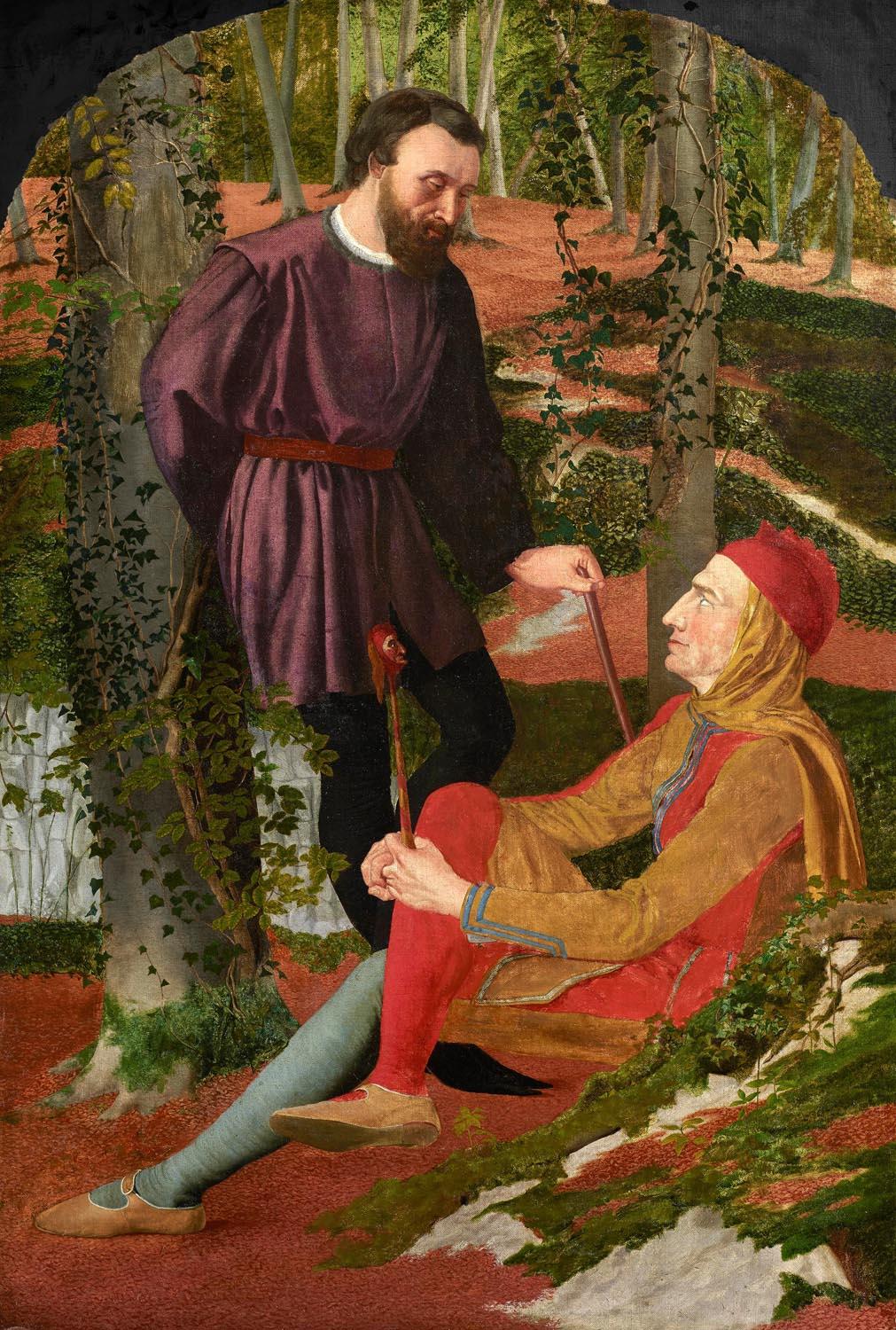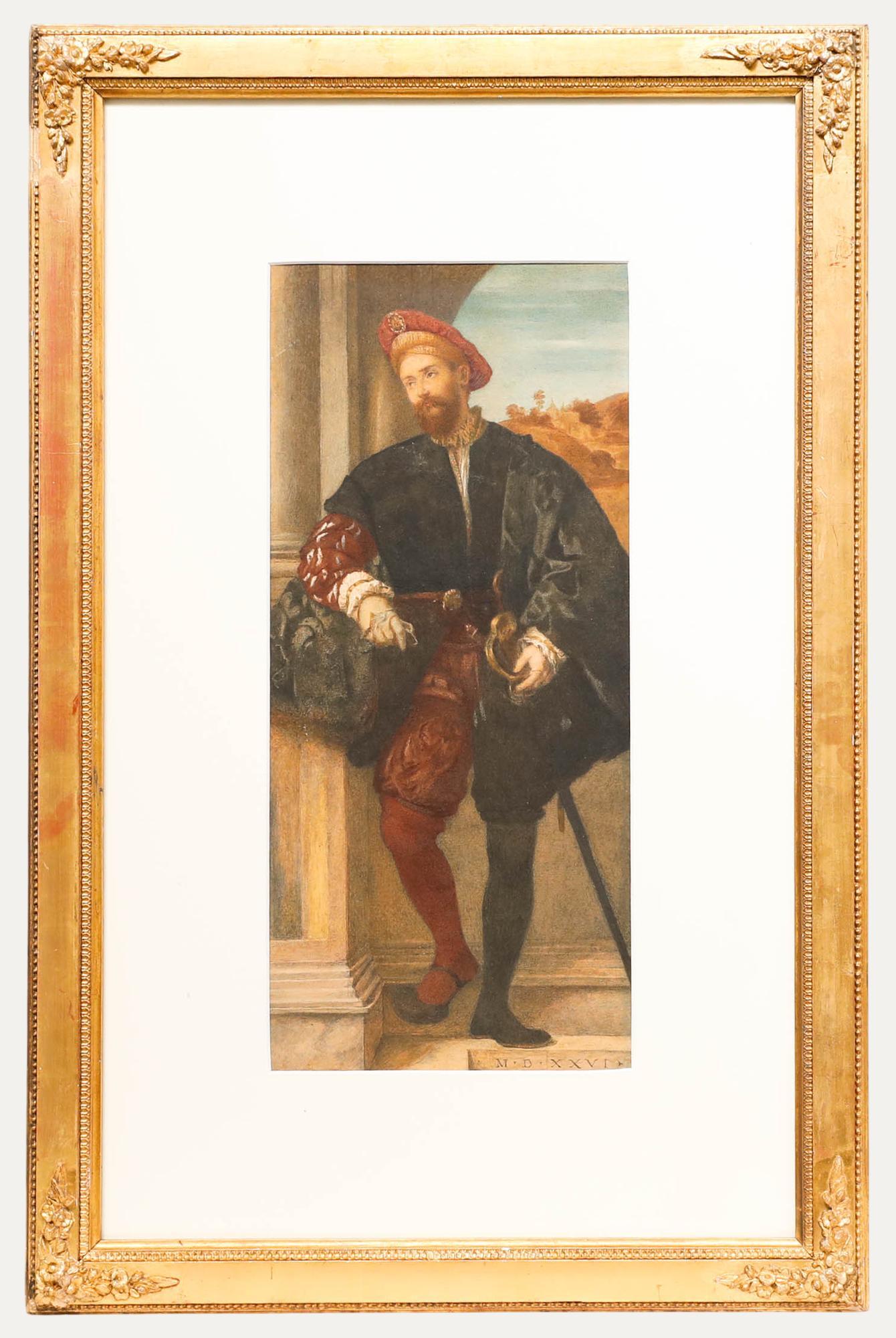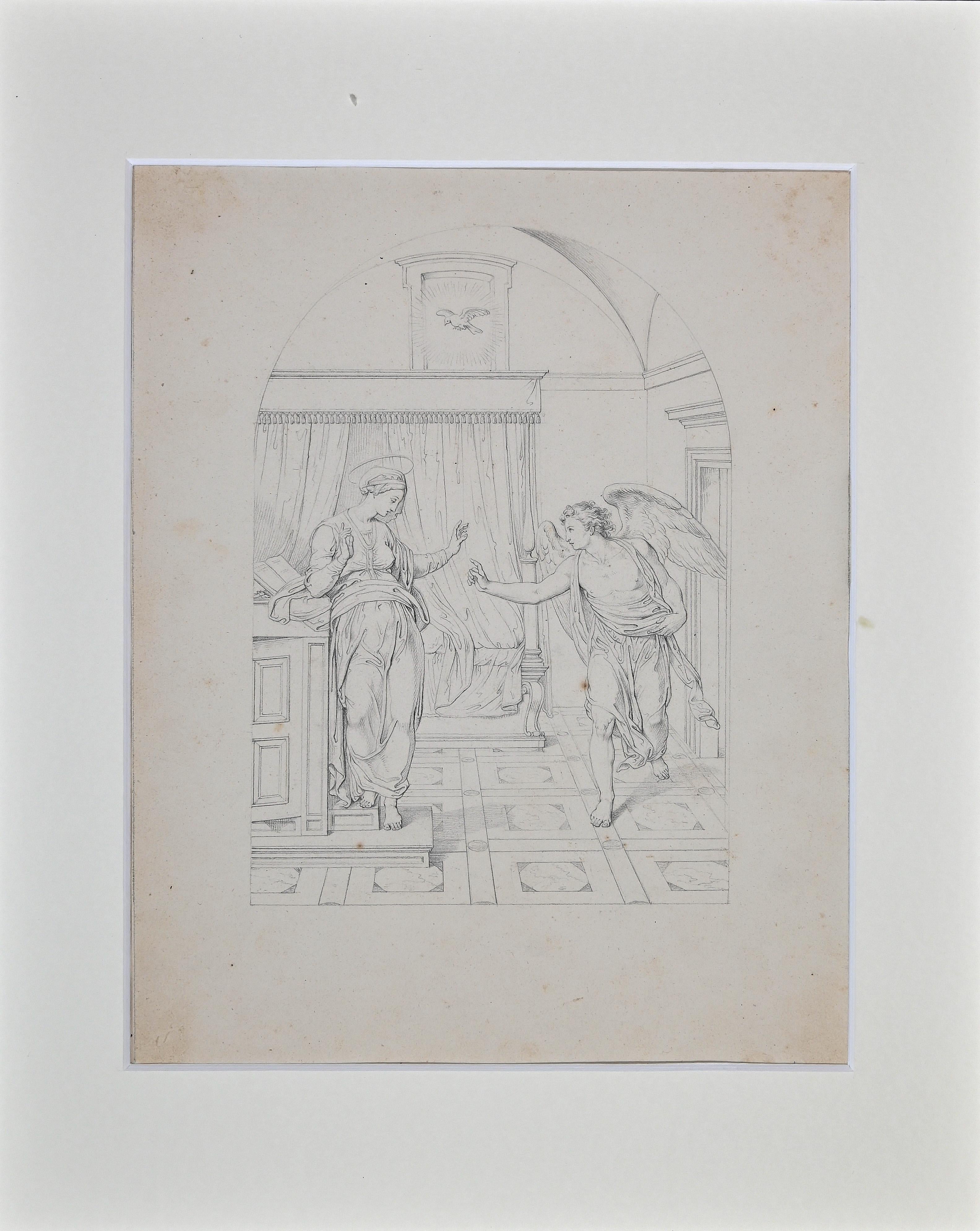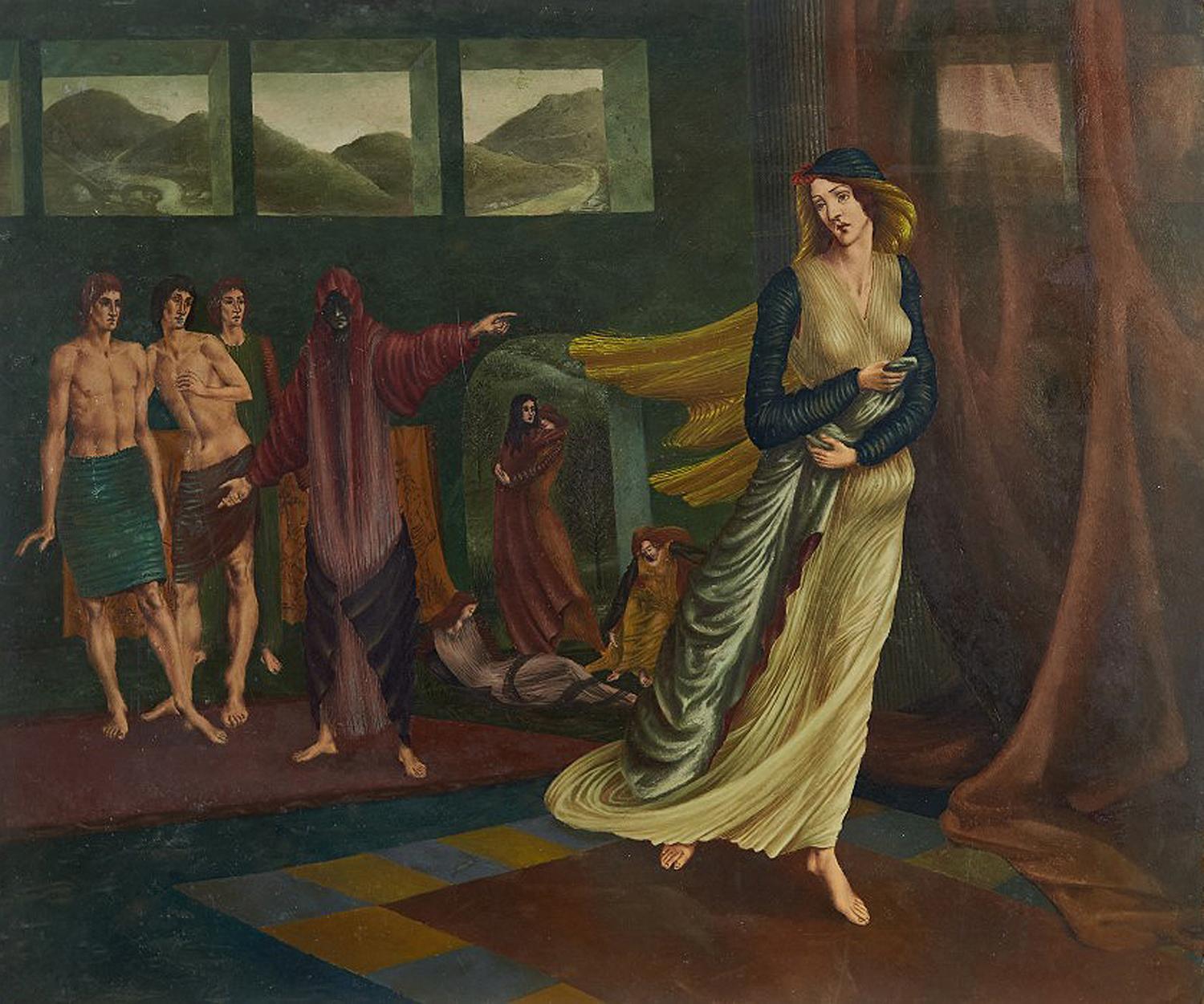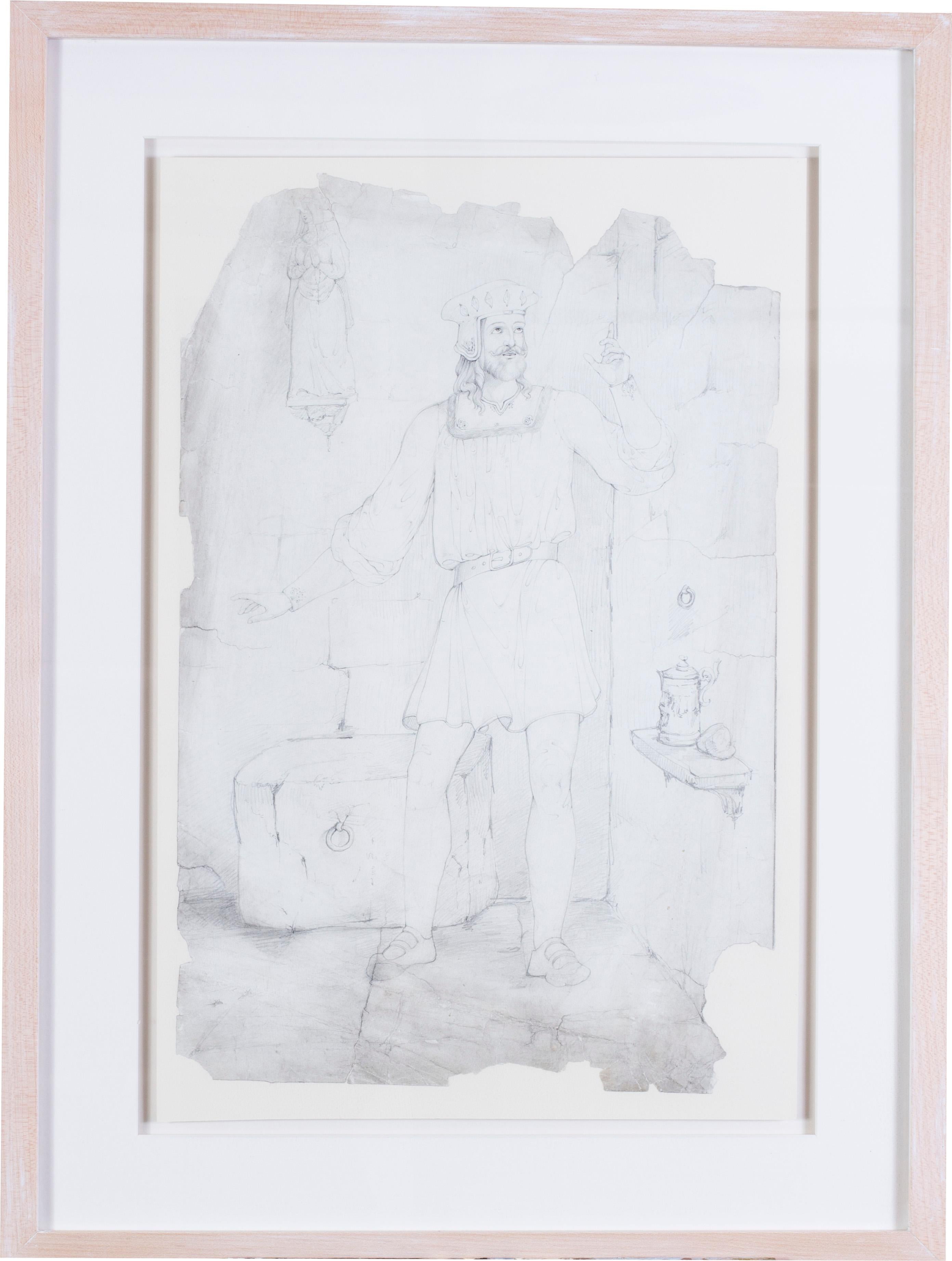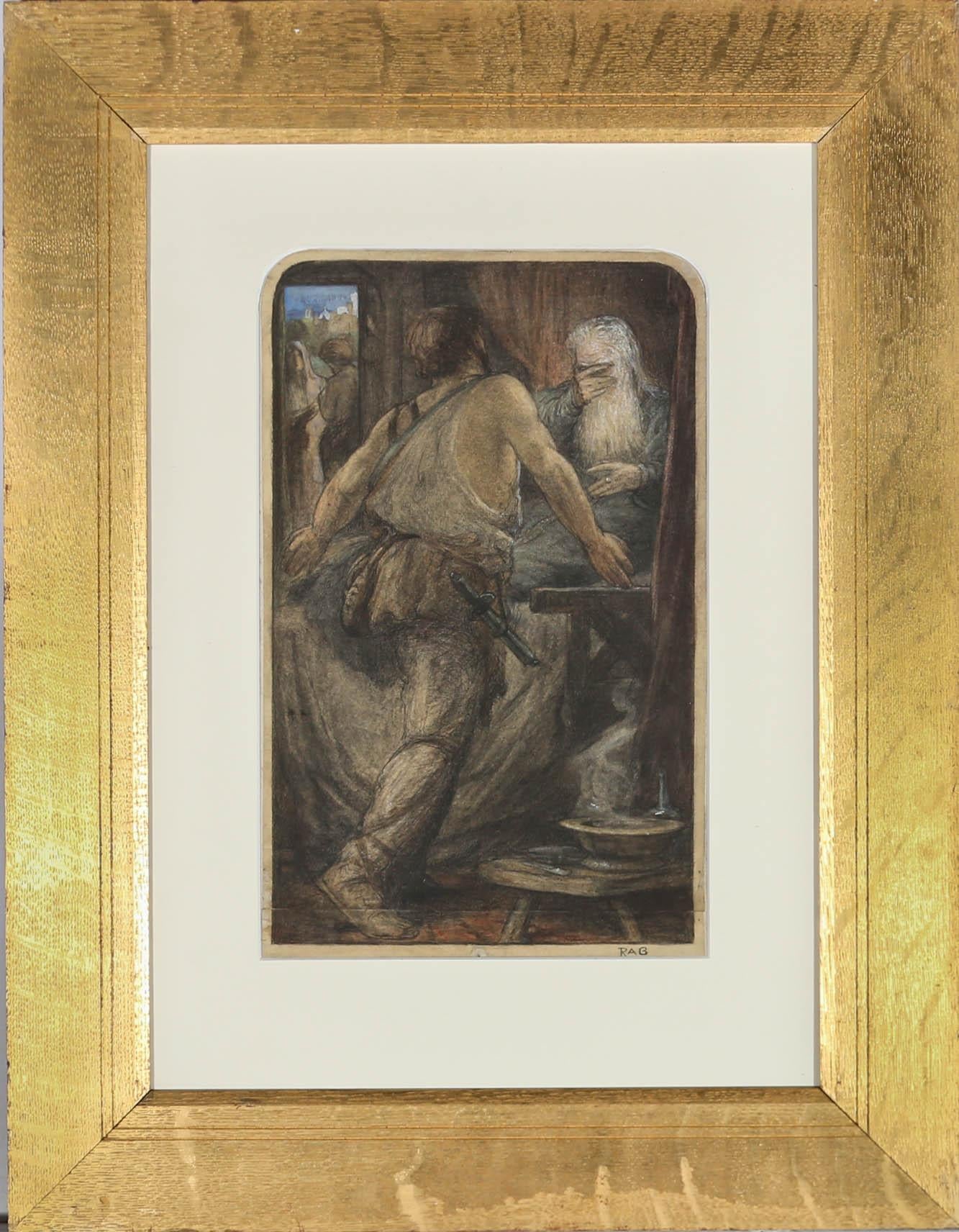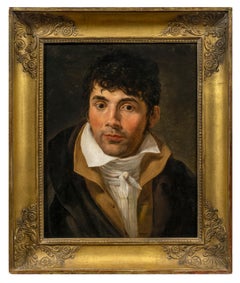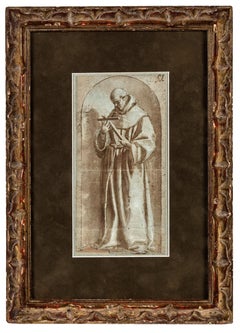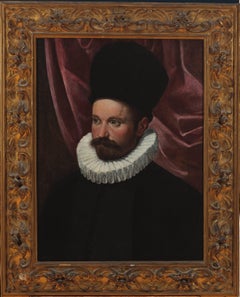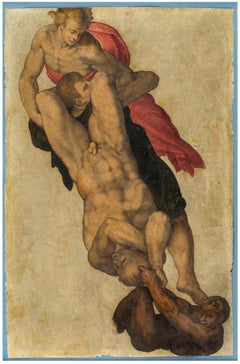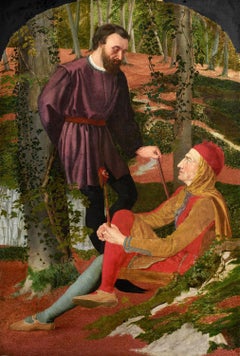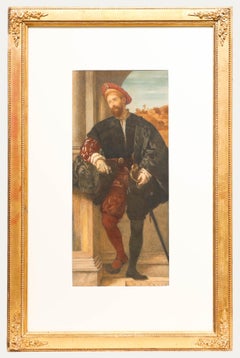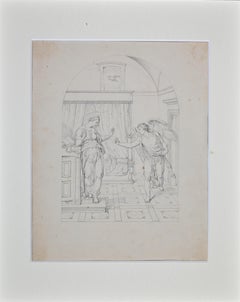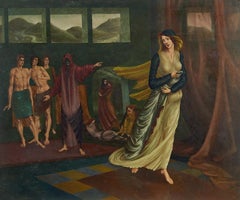Items Similar to The Argument
Want more images or videos?
Request additional images or videos from the seller
1 of 6
William Cave Thomas The Argument
$55,000
£40,812.13
€47,540.54
CA$76,560.40
A$85,256.91
CHF 44,371.51
MX$1,051,207.41
NOK 565,105.12
SEK 531,144.03
DKK 354,711.44
Shipping
Retrieving quote...The 1stDibs Promise:
Authenticity Guarantee,
Money-Back Guarantee,
24-Hour Cancellation
About the Item
Signed and inscribed on a label on the verso:
No. 1/ The Argument/ W. Cave Thomas/ 203 Camden Rd/ NW
Provenance:
Christie’s, London, 6 November 1995, lot 88.
Private Collection, London.
This powerful watercolor is a mature work by the little-known Victorian painter William Cave Thomas. Although he is generally considered a fringe member of the Pre-Raphaelite circle, possibly as a result of the rarity of his works, Thomas was a close associate of several leading members of Pre-Raphaelite Brotherhood and is credited with giving the movement’s famed periodical, The Germ, its name. Thomas here depicts a bearded man dressed in a lavish red velvet costume. The wonderfully coarse beard and fur hat suggest that the figure was inspired by a trip that the artist took to Russia. A label on the reverse of the frame written in the Thomas’s hand records the title of this work, The Argument. The close-cropping, spirited hand gestures, and penetrating stare of the figure suggests that the dispute in question is one between the protagonist of the painting and the viewer.
The son of a frame maker and gilder, Thomas studied at the Royal Academy in the 1830s and in 1840 travelled to Munich, where he attended the Academy of Fine Arts. He returned to England in 1843 and achieved modest success as an artist, art instructor, and writer in the nation’s capital. Thomas exhibited widely in London, most notably at the Royal Academy between 1843–1862 and at the Exhibition at Westminster Hall in 1845, where he won a £400 prize for a cartoon of an Allegory of Justice, which ultimately resulted in the fresco of the subject to adorn the House of Lords (in situ). In addition to working as the Master of the North London School for Drawing and Modelling in Camden, Thomas was a prolific writer and frequent contributor to the contemporary discourse on art and art education of his day. He penned numerous articles, pamphlets, and treatises on the arts, including: “The Influences Which Tend to Retard Progress of the Fine Arts” in the Builder (1848), Pre-Raphaelitism Tested by the Principles of Christianity: An Introduction to Christian Idealism (1860), and Mural or Monumental Decoration: Its Aims and Methods (1869).
Thomas’s period of study in Germany, where he came into contact with Peter von Cornelius and Johann Friedrich Overbeck, played a crucial role in his stylistic development. His paintings have often been likened to those of the German painters known as the Nazarenes that he encountered in Munich. Despite the hints of “Germanism” detected in his works—including the hard lines and the prevalence of religious subjects—Thomas’s oeuvre should be viewed within the context of the main artistic movement of his day in England: Pre-Raphaelitism. Thomas was a friend of Dante Gabriel Rossetti—one of the founding members of the Pre-Raphaelite Brotherhood—and of Ford Madox Brown, with whom he shared a studio in the 1840s.
The dynamic between the subject and the viewer in the present work is paralleled in Thomas’s painting Eliezer Offering the Earring and Bracelets to Rebecca (Fig. 1). Here, the figure of Eliezer is similarly shown bust-length and peering out of the painting. The viewer implicitly takes on the role of Rebecca, who is being offered the jewelry that Eliezer holds in his right hand. Thomas frequently worked from literary and religious sources when designing his pictures, but no source text has yet been identified for The Argument.
The figure’s beard and the fur hat—which resembles a Cossack hat—suggest that the figure may have been inspired by a trip that Thomas undertook to Saint Petersburg in the 1850s. Ford Madox Brown recorded in a diary entry dated 30 August 1854 his response to a work executed by Thomas shortly after his return from Russia: “He [Thomas] showed me a study of a Russian Merchant that quite astonished me, a most noble painting equal to anything modern or ancient.” The work seen by Ford Madox Brown was probably The Russian Dealer of the Gostvinordor, which Thomas exhibited at the National Institution exhibition the following year. That picture, which is now untraced, was judged among the best portraits in the exhibition and was described by one reviewer as an “elaborately-painted head…the fur in [which] is the very acme of imitation.” While it is tempting to associate this reference with our watercolor, it seems more likely that these were different works of closely related theme.
Thomas’s handwritten label on the verso describes the painting as “No. 1,” which suggests that it was shown as the first work in an as yet unidentified exhibition. The North West London address inscribed was one that the artist moved to around 1871. While this may suggest that the watercolor is a relatively late work, Anne Thomas, who is writing a biography of the artist, believes The Argument likely dates from the 1850s, close to the time of Thomas’s travels to Russia, but was only exhibited later in his life.
- Creator:William Cave Thomas (1820 - 1896)
- Dimensions:Height: 23.5 in (59.69 cm)Width: 18.5 in (46.99 cm)
- Medium:
- Movement & Style:
- Period:
- Condition:
- Gallery Location:New York, NY
- Reference Number:1stDibs: LU1024578721
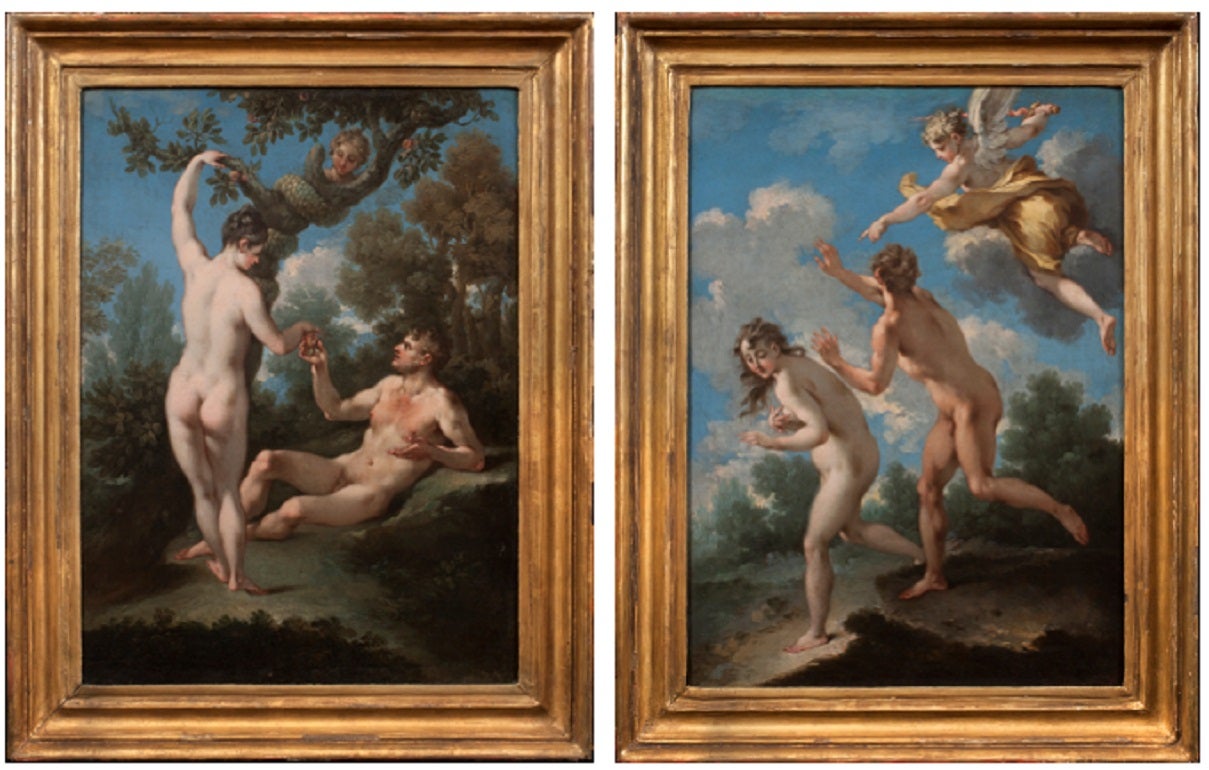
About the Seller
5.0
Recognized Seller
These prestigious sellers are industry leaders and represent the highest echelon for item quality and design.
Established in 1997
1stDibs seller since 2012
21 sales on 1stDibs
Typical response time: 12 hours
- ShippingRetrieving quote...Shipping from: New York, NY
- Return Policy
Authenticity Guarantee
In the unlikely event there’s an issue with an item’s authenticity, contact us within 1 year for a full refund. DetailsMoney-Back Guarantee
If your item is not as described, is damaged in transit, or does not arrive, contact us within 7 days for a full refund. Details24-Hour Cancellation
You have a 24-hour grace period in which to reconsider your purchase, with no questions asked.Vetted Professional Sellers
Our world-class sellers must adhere to strict standards for service and quality, maintaining the integrity of our listings.Price-Match Guarantee
If you find that a seller listed the same item for a lower price elsewhere, we’ll match it.Trusted Global Delivery
Our best-in-class carrier network provides specialized shipping options worldwide, including custom delivery.More From This Seller
View AllPortrait of a Gentleman
Located in New York, NY
Circle of Jacques-Louis David
(French, 18th Century)
Provenance:
Private Collection, Buenos Aires
Exhibited:
“Art of Collecting,” Flint Institute of Art, Flint, Michigan, 23 November 2018 – 6 January 2019.
This vibrant portrait of young man was traditionally considered a work by Jacques-Louis David, whose style it recalls, but to whom it cannot be convincingly attributed. Rather, it would appear to be by a painter in his immediate following—an artist likely working in France in the first decade of the nineteenth century. Several names have been proposed as the portrait’s author: François Gérard, Louis Hersent, Anne-Louis Girodet (Fig. 1), Theodore Gericault, and Jean-Baptiste Wicar, among others. Some have thought the artist Italian, and have proposed Andrea Appiani, Gaspare Landi...
Category
18th Century Old Masters Paintings
Materials
Canvas, Oil
$45,000
Study of a Franciscan Saint, probably San Diego de Alcalá
Located in New York, NY
Provenance: Ivan E. Phillips, Montreal and New York, until 2023.
The brothers Bartolomé Carducho and Vicente Carducho, both born and trained in Florence, settled in Spain where they made their careers. Vicente worked on numerous commissions for both the church and the Spanish court...
Category
17th Century Old Masters Drawings and Watercolor Paintings
Materials
Paper, Chalk, Ink, Pen
Portrait of a Gentleman
By Ippolito Scarsella (Scarsellino)
Located in New York, NY
Provenance: Suida-Manning Collection, New York
Private Collection
Exhibited: Venetian Paintings of the Sixteenth Century, Finch College Museum of Art, New York, October 30-December 15, 1963, no. 31.
Veronese & His Studio in North American Collections, Birmingham Museum of Art, Oct. 1-Nov. 15, 1972, and Montgomery Museum of Fine Arts, Dec. 5-Dec. 31, 1972
Literature: Robert L. Manning, A Loan Exhibition of Venetian Paintings of the Sixteenth Century, exh. cat. New York 1963, cat. no. 31ill., as by Veronese
Stephen Clayton and Edward Weeks, eds., introduction by David Rosand, Veronese & His Studio in North American Collections, Birmingham 1972, as by Veronese, p. 38 ill.
Terisio Pignatti, Veronese, Venice 1976, I, p. 199, cat. no. A225, II, fig. 908, as attributed to Veronese
Terisio Pignatti and Filippo Pedrocco, Veronese; catalogo completo dei dipinti, Florence 1991, no. 54°, as attributed to Veronese.
Terisio Pignatti and Filippo Pedrocco, Veronese, Milan 1995, II, pp. 517-518ill., cat. no. A 56, under attributed paintings, by Veronese and workshop)
John Garton, Grace and Grandeur; The Portraiture of Paolo Veronese, London-Turnhout 2008, p. 237, fig. 77, cat. no. R16, as workshop of Veronese.
Scarsellino’s art is widely regarded as critical link between the Renaissance and the Baroque styles in Emilian painting; not only was he an important transmitter of the heritage of the Renaissance, but he was also open to innovative ideas, and was one of the earliest to experiment with the trend to naturalism that would become fundamental to art of the new century. Born around 1550, he received his earliest training from his father Sigismondo, an architect and painter; it was probably while working at his father’s side as a youth that he acquired the nickname Scarsellino, or “little Scarsella”. After absorbing the principles of his art in Ferrara and Parma, he went to Venice in 1570, staying for four years and working in the shop of Veronese. In the following decade, his art —especially in terms of its piety and its development of landscape— demonstrates a strong sympathy with that of the Carracci, with whom he worked in 1592-1593 at the Palazzo dei Diamanti in Ferrara. Maria Angela Novelli and later Alessandra Frabetti both propose that Scarsellino traveled to Rome, although such a trip has not been documented; if he did travel to Rome, it probably would have occurred during the years that Scarsellino’s colleagues Agostino and Annibale Carracci were there, that is, beginning in 1595 and until 1609. The last decades of Scarsellino’s career again involve stylistic experimentation, this time in a manner that would bring his work very close to the progressive figurative naturalism of Carlo Bononi and prepare the way for Guercino.
The present portrait of a distinguished gentleman had been long thought to be by Paolo Veronese and was in fact attributed to him by such distinguished connoisseurs as Adolfo Venturi and Wilhelm Suida. The portrait’s style is, however, distinct from Veronese’s, although clearly indebted to it, and the attribution to the young Scarsellino is wholly convincing. The painting would then date from the 1570s – a date confirmed by the costume the subject wears. The puffed hat that appears in the painting had a rather short-lived vogue in the early 1570s. One sees it in Giambattista Moroni’s Portrait of Count...
Category
18th Century and Earlier Baroque Portrait Paintings
Materials
Canvas, Oil
Study after Michelangelo’s “The Last Judgment”
By Michelangelo Buonarroti
Located in New York, NY
Italian School, 16th Century
Provenance:
Private Collection, New York
This intriguing drawing is a study by an anonymous 16th-century Italian artist after a vignette in Michelangelo’s fresco of The Last Judgement in the Sistine Chapel. The altar wall of the Sistine Chapel was already richly decorated when Pope Clement VII commissioned Michelangelo to paint his Last Judgment...
Category
16th Century Old Masters Figurative Drawings and Watercolors
Materials
Paper, Gouache
Portrait of a Man
Located in New York, NY
Provenance:
with Leo Blumenreich and Julius Böhler, Munich, 1924
Dr. Frederic Goldstein Oppenheimer (1881-1963), San Antonio, Texas; by whom given to:
Abraham M. Adler, New York, until 1985; thence by descent to the present owners
While old inscriptions on the verso of this panel propose its author to be Hans Holbein and the sitter Sir John More—a lawyer, judge, and the father of Sir Thomas More—this fine portrait has long been recognized to be by a Flemish hand. Max Friedländer gave the painting to Bernard van Orley (1487/1491 – 1541) in 1924, but did not include it in the volume dedicated to the artist in his Early Netherlandish Paintings...
Category
16th Century Old Masters Portrait Paintings
Materials
Oil, Panel
$52,500
Woman in Fantasy Costume (pair)
By Jean Baptist Le Prince
Located in New York, NY
The pair consists of the present work and an engraving after it by the hand of Giles DeMarteau (Liège 1722 – 1776 Paris) titled Woman in Fantasy Costume, after Jean Baptiste Le Prince, and measuring, 10 ⅜ x 8 ⅝ inches (26.5 x 22 cm).
DeMarteau's engraving is inscribed at the bottom:
Le Prince inv. del. / Demarteau sc. / A Paris ches Demarteau Graveur du Roi, rue de la Pelterie à la Cloche...
Category
18th Century Drawings and Watercolor Paintings
Materials
Paper, Chalk, Engraving
You May Also Like
Touchstone and Corin, British Pre-Raphaelite 19th Century Oil on Canvas
Located in London, GB
Adolphus M. Madot
Circa 1833 - 1861
Oil on canvas
Image size: 36 x 24 inches (91.4 x 61 cm)
Arched Pre-Raphaelite style frame
The subject of the present picture is the dialogue between the court jester Touchstone and the shepherd Corin in the Forest of Arden ( As You Like It, Act III, scene 2). The work of William Shakespeare 'As You Like It' was a popular literary source in Pre-Raphaelite circles, inspiring such artists as John Everett Millais, Walter Howell Deverell and Arthur Hughes. The present picture is comparable in style to the work of Edward W. Rainford and Henry Stacy Marks...
Category
1850s Pre-Raphaelite Figurative Paintings
Materials
Oil
After Moretto - Italian 19th Century Watercolour, Portrait of a Man
Located in Corsham, GB
A fine 19th century watercolour copy of Italian Renaissance painter, Moretto's, Portrait of a Man. Dated in Roman numerals to the lower right (1562). Presented in an ornate gilt effe...
Category
19th Century Portrait Drawings and Watercolors
Materials
Watercolor
The Announcement - Drawing by Giovanni Fontana - 16th Century
By Giovanni Fontana
Located in Roma, IT
The announcement in S. Maria sopra Minerva is an original drawing in pencil on paper, realized by Giovanni Fontana.
The state of preservation of the artwork is good except for some ...
Category
16th Century Figurative Drawings and Watercolors
Materials
Paper, Pencil
Exiled, Early 20th-Century Pre-Raphaelite Oil on board
By Francis Plummer
Located in London, GB
Francis Plummer
1930 - 2019
Exiled
Oil on board
Image size: 20 ½ x 24 ½ inches
Framed
This rare collection of works from the artists estate, painted i...
Category
Mid-20th Century Pre-Raphaelite Figurative Paintings
Materials
Oil
Pre-Raphaelite, early 19th Century drawing by the British artist Lord Leighton
By Frederic Leighton
Located in Petworth, West Sussex
Lord Frederick Leighton (British, 1830-1896)
A Medieval Allegory
pencil on paper
the fragment measures approx. 19.1/2 x 13 in.
(49.5 x 33 cm.)
Provenance: Gifted by Leighton to his cousin Edith Emily Jellicorse, nee Garnham, and thence by descent.
We would like to thank Daniel Robins, the curator at Leighton House for the authenticating this work in full.
Daniel has suggested this study would have been executed when Leighton was studying in Frankfurt
Leighton was born in Scarborough to Augusta Susan and Dr. Frederic Septimus Leighton. He received his artistic training on the European continent, first from Eduard von Steinle and then from Giovanni Costa. According to Daniel Robbins, the curator at Leighton House, This drawing comes from the time Leighton studied under Eduard von Steinle. He then studied at the Accademia di Belle Arti in Florence. From 1855 to 1859 he lived in Paris, where he met Ingres, Delacroix, Corot and Millet. In 1860, he moved to London, where he associated with the Pre-Raphaelites. In 1864 he became an associate of the Royal Academy and in 1878 he became its President (1878–96). American art critic Earl Shinn claimed at the time that "Except Leighton, there is scarce any one capable of putting up a correct frescoed figure in the archway of the Kensington Museum." His paintings represented Britain at the great 1900 Paris Exhibition. Leighton was knighted at Windsor in 1878 and was created a baronet, of Holland Park Road eight years later. He was the first painter to be given a peerage. Leighton remained a bachelor and rumours of him having an illegitimate child with one of his models, in addition to the supposition that Leighton may have been a homosexual, continue to be debated. On his death his barony was extinguished after existing for only a day; this is a record in the Peerage. His house in Holland Park, London has been turned into a museum. It contains many of his drawings and paintings, as well as some of his former art collection including a painting dedicated to Leighton by Sir John Everett Millais. The house also features many of Leighton's inspirations, including his collection of Iznik tiles. Its centrepiece is the magnificent Arab Hall. Leighton was an enthusiastic volunteer soldier, enrolling with the first group to join the 38th Middlesex (Artists') Rifle Volunteer Corps (later to be known as the Artists Rifles...
Category
19th Century Pre-Raphaelite Figurative Drawings and Watercolors
Materials
Paper, Pencil
Robert Anning Bell (1863-1933) - Early 20thC Watercolour, The Confrontation
By Robert Anning Bell
Located in Corsham, GB
A striking, unidentified Biblical scene in pencil and watercolour, showing a man with a dagger in his sheath at his side, aggressively approaching an older man who hides his face. A ...
Category
Early 20th Century Figurative Drawings and Watercolors
Materials
Watercolor
More Ways To Browse
Jewelry W Provenance
Crop Circles
Red Fringe Dress
Antique Russian Earrings
Antique Pamphlets
Paintings Cossacks
Dante Bust
Costume Jewelry Lots
Royal Costume Jewelry
Bearded Man Bust
Antique Dante Bust
Dante Gabriel Rossetti
Dante Jewelry
Ford Madox Brown
Rebecca And Eliezer
Acme Jewelry
Art Horizontal Painting
Fabric Artwork
